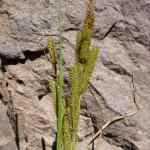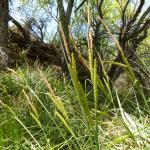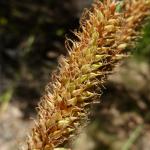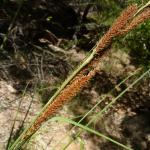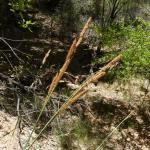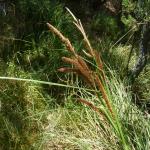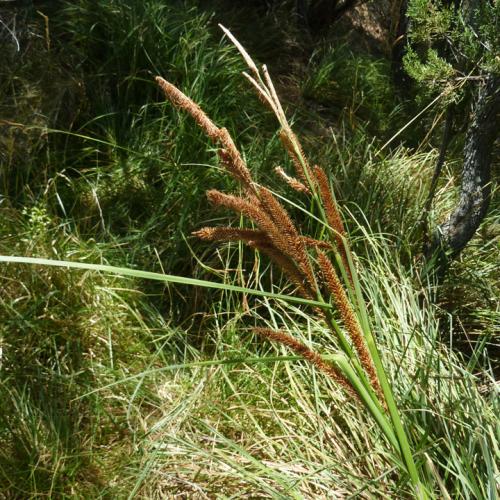Carex ultra (A Sedge)
Carex spissa var. ultra (L. H. Bailey) Kuk.
| USFWS | State of NM | USFS | BLM | Navajo Nation | State Rank | Global Rank | R-E-D Code | NMRPTC Status | Strategy Status |
|---|---|---|---|---|---|---|---|---|---|
| S1 | G3 | D | SS |
| Overall Conservation Status | Documented Threats | Actions Needed |
|---|---|---|
| EFFECTIVELY CONSERVED | No Information |
Document threats, taxonomic work |
Plants densely cespitose from stout rhizomes; culms 50-160 cm tall; leaf blades 6-15 mm wide, sometimes glaucous, thick, stiff, scabrous on margins and keel, basal sheaths brown or reddish, with fronts densely red-spotted or blotched, ladder-fibrillose; inflorescence 18-50 cm long, composed of 1-3 terminal staminate spikes, each 2-12 cm long, and 3-6 erect lateral pistillate spikes, each 2-13 cm long, cylindric, the lowest spike stiffly long-pedunculate, the proximal bract leaf-like, shorter or longer than the inflorescence; pistillate scales shorter than to as long as the perigynia, the apices acute to acuminate, the tip often ciliate-serrulate; perigynia 2-5 mm long, 1.4-2.2 mm wide, lance-oblong or obovoid, appressed-ascending, pale green to reddish-brown, with red-brown spots, nerved or not, compressed trigonous and slightly inflated above, beak 0.2-0.6 mm long; stigmas 3; achenes 1.9-2.2 mm long. Flowers March to July.
Carex amplifolia and C. senta are two other robust Carex of southern NM with long and narrow pistillate spikes. Carex amplifolia has brown to brownish green perigynia with subspherical bodies abruptly constricted to long, narrow, sometimes bent beaks (0.7-1.1 mm), while C. ultra has pale green to reddish brown perigynia with red-brown spots and are narrowly obovoid with short, stubby beaks (0.2-0.6 mm). Carex senta flowers have two stigmas and lenticular achenes, while C. ultra flowers have three stigmas and compressed trigonous achenes. C. senta occupies the banks of major rivers and streams, while C. ultra is found at springs, along washes with subsurface flow and on banks of smaller, slower-moving streams. The common wetland sedge Carex utriculata has thicker pistillate spikes with spreading perigynia that have prominent beaks much longer (0.8-1.8 mm) than those of C. ultra.
New Mexico, Peloncillo Mountains of Hidalgo County; Arizona, Cochise, Gila, Graham, Maricopa, Pima, Pinal, Santa Cruz, Yavapai counties; adjacent Mexico.
Springs, seasonal and dry washes with subsurface water flow, and banks of small streams. 550-2000 m (1800-6500 ft.)
Carex ultra is endemic to SE and central AZ with a few populations in adjoining Mexico and just 2 small populations in adjoining New Mexico. Arizona botanist Max Licher estimates that populations exist in nearly 50 locations in Arizona. The populations are of varying size, some large, but most are highly localized and concentrated.
Projected increased drought and increases in temperature as a result of climate change may severely impact the habitat of this species as springs may be subject to drying up.
Hermann, F. J. 1970. Manual of the Carices of the Rocky Mountains and Colorado Basin. USDA Agricultural Handbook No. 374.
Licher, M. 2020. Personal communication. Arizona botanist specializing in Cyperaceae and Juncaceae, based in the Deaver Herbarium, NAU, in Flagstaff, AZ.
Licher, M.H., J. McGrath, W.R. Norris, & G.R. Rink. in press. Carex, p. 69-96. IN: Flora Neomexicana III: An Illustrated Identification Manual, Part 1. lulu.com.
Rink, G. and M. Licher. 2015. Vascular Plants of Arizona: Cyperaceae Sedge Family Part 1: Family Description, Key to the Genera, and Carex L. CANOTIA 11: 1-97.
For distribution maps and more information, visit Natural Heritage New Mexico

